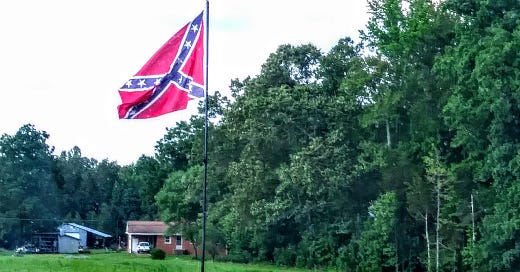Alamance County, NC: Ground Zero for the Hyper-Partisan Divide in America
Similar to the Middle East?
I initially joked that upon returning from teaching in the Middle East it was difficult to navigate Alamance County, NC’s diverse cultures, tribes, and divisions. I observed country folk and city folk, neo-Confederates and transplanted Yankees, Native Americans, African Americans, and Latinos; highly educated PhDs and high school drop-outs; people who welcomed diversity and immigrants and people who outwardly expressed suspicions of “them.”
Then I summed it up: “Alamance County is REAL America,” not an ivory tower and not many elitist, gated neighborhoods, not a place where most people think and vote alike. I saw it as a kind of microcosm of America, a solidly “red” Republican county where working-class folks in manufacturing, textiles, and service industries and people who work with their hands live next door or in the same neighborhood as college professors and high-tech entrepreneurs. House prices were still quite reasonable, far cheaper than in the neighboring “blue” Democratic counties of Guilford, Orange, and Durham.
Returning from nearly a decade teaching in the United Arab Emirates and Turkey, my wife and I rented a house in Burlington, NC (Alamance County) for two-and-a-half years before returning to the home we own near Chapel Hill (Orange/Chatham Counties). The cultures of the two places could not be more different, reflecting red and blue America. We enjoy both.
Lower Prices, Less Crowded, Genteel
One of the first things my wife noticed was that the customers at the fantastically-low-priced Aldi’s grocery store in Burlington were so much more polite than those in the more bustling, less “Southern” areas like Durham. Aldi’s charges 25 cents to rent grocery carts. In Durham, customers compete for carts. In Burlington, customers offer you their cart for free, or quickly give you a quarter if you don’t have one. But that genteel “way of life” may soon change, as Alamance County is discovered and experiences steady population growth.
The county has received negative national publicity over three hot-button issues — Confederate monuments; Latino immigrants; and confrontations between Trump supporters and “(liberal) academic elites” at the local Elon University. Yet if you live here, people of diverse backgrounds seem to get along pretty well most of the time. That’s one of the things we like about Alamance.
The neighborhood where we lived was almost evenly divided among Democrats, Republicans, and unaffiliated voters. This made for an interesting, eclectic atmosphere, not “group-think.”
For this reason, the county is growing, at least seven percent since 2010, with lots of migrants from northern states settling in new suburbs such as
Keep reading with a 7-day free trial
Subscribe to Slender Threads / Global Citizens / Public History to keep reading this post and get 7 days of free access to the full post archives.




